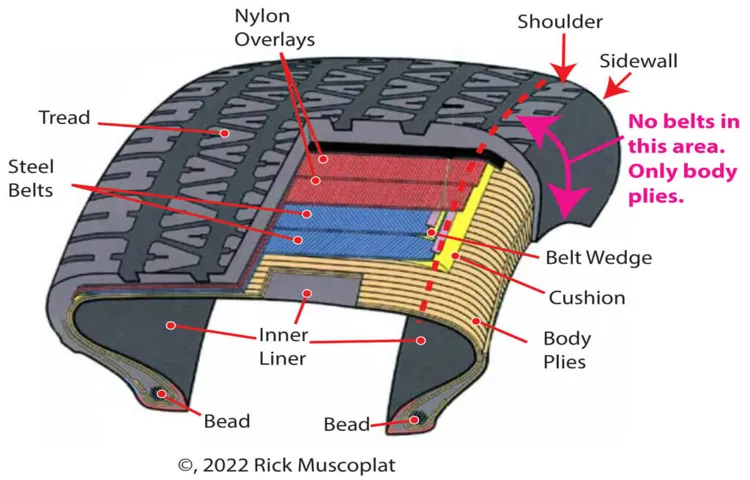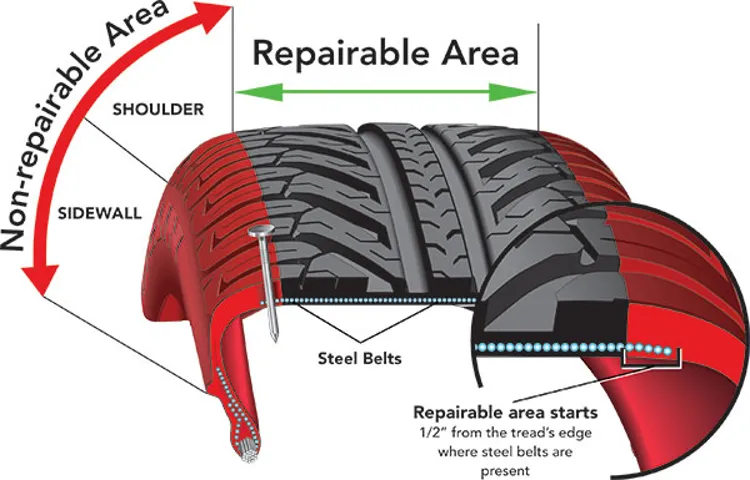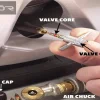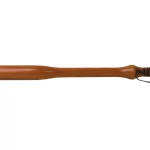Have you ever had a flat tire on the highway and decided to patch it up with a quick fix? It may have worked for a short time, but what if the puncture was on the tire’s shoulder, or sidewall? Unfortunately, patching a tire’s shoulder is not an option. In this blog post, we’ll explore why you can’t patch a tire shoulder and the dangers of driving on a patched shoulder. So let’s dive in and get to the root of the problem! Your tire’s shoulder is the area between the sidewall and the tread, which is responsible for supporting your vehicle’s weight and absorbing shock.
Punctures or cuts in this area can weaken the overall structure of the tire, making it unsafe for driving. Patching a tire shoulder may seem like a cost-effective solution, but it’s not reliable. A tire’s shoulder is exposed to a lot of stress and pressure, which means that patching it up won’t fix the root cause of the problem.
Driving on a patched tire shoulder is risky business. A patched tire might look fine on the outside, but it can easily fail while driving. When a patch is applied, it creates a weak spot on the tire that can’t withstand the pressure of driving, leading to a blowout.
A blowout can be catastrophic, especially if you’re driving at high speeds. Imagine losing control of your car and potentially causing an accident – all because of a patched-up tire shoulder. In conclusion, patching a tire shoulder is not a viable option.
It might seem like a simple fix, but it could end up endangering your life and the lives of others on the road. If you have a puncture or cut on your tire’s shoulder, the best course of action is to replace the tire entirely. Remember, safety always comes first when it comes to driving.
Table of Contents
Understanding Tire Shoulders
One of the essential parts of a tire is its shoulder, the section where the tread and sidewall meet. The shoulder plays a crucial role in providing stability, enhancing traction, and absorbing shock from the road surface. Hence, any damage to the shoulder can significantly impact the tire’s performance and jeopardize the driver’s safety.
That’s why tire technicians don’t recommend patching a tire shoulder. Unlike the crown area that carries almost all the weight, the shoulder endures more stress during cornering and turning. Besides, a patch cannot bond adequately with the shoulder due to its sloping angle, which requires a lot of pressure and heat to create a sturdy seal.
Attempting to patch a tire shoulder may result in further damage, causing the tire to lose air pressure, bulge, or even burst unexpectedly. Therefore, if you notice a puncture or cut on your tire’s shoulder, it’s best to replace the tire altogether with a new one to avoid risking your safety on the road.
Definition and Location
Tire shoulders refer to the area on the sides of a tire where the tread meets the sidewall. These parts are important because they are the main contact point between the tire and the road. This means that the quality of the shoulders can determine the performance and safety of your vehicle.
Tire shoulders come in different shapes and sizes depending on the type of tire and the intended use. For example, a tire designed for high-speed performance may have a more rounded shoulder while a tire designed for off-road driving may have a more squared-off shoulder for better traction. Always make sure to inspect your tire shoulders regularly to identify any signs of damage or wear and replace them if necessary to ensure optimal performance and safety.

Importance in Tire Functionality
Tires are an essential part of any vehicle, and understanding the tire shoulders’ function is crucial to ensuring optimal functionality. The tire shoulder is the area of the tire located between the sidewall and the tread. It is responsible for providing support, stability, and flexibility to the rest of the tire.
The shoulder is where the tire meets the road, and it absorbs the shock from bumps, potholes, and other irregularities on the road surface. This part of the tire is also responsible for maintaining the proper tire pressure by preventing air leakage. Overall, the shoulder plays a vital role in ensuring the tire’s functionality and lifespan.
Understanding how it works can help individuals take better care of their vehicle and prolong the life of their tires.
Limitations of Patching Tire Shoulders
“Why can’t you patch a tire shoulder?” Well, patching a tire shoulder is not recommended for multiple reasons. First, the shoulder is a crucial part of the tire, responsible for supporting the weight of your vehicle and helping you maintain proper handling and control. Second, patching the shoulder could weaken it, reducing its ability to support the tire and potentially causing a blowout while driving.
Third, a patch on the shoulder may not adhere properly, leading to air leakage and requiring frequent trips to the mechanic. It is essential to inspect your tire regularly for any damage or wear and replace it if necessary to ensure your safety on the road. Remember, prevention is always better than a cure.
Don’t take a chance on the safety of yourself and other drivers on the road by trying to patch a tire shoulder. Replace the tire if needed and be sure to maintain good tire condition.
Safety Concerns
When it comes to tire repairs, safety should always be a top priority. While patching tire shoulders might seem like a quick fix, there are limitations to this approach. It’s important to consider the size and location of the damage on the tire.
If the shoulder area is too damaged, patching may not provide a long-term solution. In addition, high-performance and heavy-duty tires may not be suitable for patching at the shoulder due to their unique construction and material composition. In these cases, it’s best to consult with a professional tire technician to determine the best course of action for repairing the tire.
Ultimately, it’s better to be safe than sorry when it comes to tire safety, and investing in a new tire may be the safest choice rather than trying to patch an unsuitable area.
Challenges in Proper Repairs
When it comes to repairing tires, there are several challenges that mechanics face. One of the most significant limitations of patching tire shoulders is that it can be difficult to get the patch to adhere properly. Tire shoulders are the part of the tire that comes into contact with the road, and they are under a lot of pressure and constant movement.
This makes it hard for a patch to stay in place, and it can easily come loose over time. Additionally, if the damage to the tire shoulder is severe, patching may not be a viable option at all. In such cases, the only option may be to replace the tire altogether.
Thus, while patching the shoulders of tires can be effective, it is not always a reliable solution, and mechanics must be aware of its limitations.
Risk of Tire Failure
Tire failure can be a dangerous and frightening experience for any driver. The tire shoulder, which is the area where the tire tread meets the sidewall, is particularly susceptible to damage and wear. While it is possible to patch small punctures or cuts in the tread, there are limitations when it comes to repairing tire shoulders.
Patching a tire shoulder is not recommended as it weakens the tire’s structural integrity and can lead to a blowout. It’s best to replace a damaged tire shoulder with a new one to ensure maximum safety on the road. Think of it like a broken bone – a simple patch may help in the short-term, but it’s not a long-term solution.
It’s always better to be safe than sorry when it comes to tire safety. So, keep an eye out for any signs of wear or damage on your tires, and get them replaced by a professional if needed. By taking these precautions, you can minimize the risk of tire failure and keep yourself and your passengers safe on the road.
Alternatives to Patching Tire Shoulders
Have you ever wondered why you can’t patch a tire shoulder? Well, patching a tire shoulder is not recommended as it compromises the safety of the tire. Tire shoulders are the sides of the tire that provide stability and support when turning. They are also responsible for the tire’s ability to maintain traction during cornering.
A puncture or damage to the tire shoulder can significantly weaken the tire’s structure, resulting in a higher risk of a blowout or a loss of control while driving. Repairing tire shoulders is not only dangerous but also ineffective. The patch may not hold due to the uneven surface, and there is a likelihood of the damage spreading, which translates to a high likelihood of a tire failure.
Therefore, it is advisable to replace the tire instead of attempting to patch the tire shoulder. Safety on the road should be a top priority, and replacing a damaged tire is a small price to pay for one’s safety and that of others.
Replacing the Damaged Tire
When it comes to tire damage, sometimes patching isn’t the best solution – especially when it comes to the shoulders of the tire. The shoulder is where the tire meets the sidewall, and if it’s damaged, it can severely impact the integrity and safety of the tire. Fortunately, there are alternatives to patching that are just as effective.
One option is to replace the damaged tire completely. While this can be a pricier solution, it will ensure that you have a new tire with strong shoulders for safer driving. Another alternative is to consider retreading the tire, which involves removing the damaged portion and replacing it with new rubber.
This option is less expensive than replacing the tire entirely, but it’s important to note that not all tires can be retreaded. Ultimately, the best solution depends on the extent of the damage and the type of tire you have. However, by considering alternatives to patching, you can ensure that you’re driving safely and with confidence.
Using Temporary Sealants
Temporary sealants are a great option for those looking for an alternative to patching tire shoulders. These sealants work by filling in any punctures or small leaks in the tire, allowing you to continue driving without the need for a patch. Not only are they easy to use, but they also provide a quick fix, saving you time and money.
One popular option is the tire plug kit, which includes a rubber plug and a glue-like substance for inserting into the puncture. Another option is a spray-on sealant, which coats the inside of the tire and forms a temporary seal when it comes into contact with air. While these are only temporary solutions and may not work for larger punctures, they can be a great option for small leaks while you wait for a more permanent repair.
Don’t let a small puncture or leak ruin your day – consider using a temporary sealant as a quick and easy fix.
Conclusion
When it comes to patching a tire, you might think it’s as easy as slapping a Band-Aid on a boo-boo. But the reality is, patching a tire shoulder is a whole different ballgame. You can’t just throw a patch on there and hope for the best.
The tire shoulder experiences a lot of stress and strain, and it serves as a crucial support for the rest of the tire. So, if you attempt to patch it, not only do you risk compromising the integrity of the tire, but you also risk putting yourself in danger on the road. Bottom line: Leave the tire shoulder to the professionals, and stick to Band-Aids for your boo-boos.
“
FAQs
What is a tire shoulder?
A tire shoulder is the part of the tire that extends from the tread to the sidewall.
Why is it important not to patch a tire shoulder?
It is important not to patch a tire shoulder because it is a structurally critical area that experiences high levels of stress and strain.
What happens if you patch a tire shoulder?
If you patch a tire shoulder, the patch may not hold, and the tire can fail catastrophically, leading to a dangerous blowout.
Can you replace a tire shoulder?
No, it is not possible to replace a tire shoulder. If the tire shoulder is damaged, the entire tire must be replaced.
Is it possible to prevent tire shoulder damage?
Yes, tire shoulder damage can be prevented by properly maintaining your tires, avoiding overloading your vehicle, and avoiding potholes and other road hazards.
How often should you inspect your tire shoulders?
You should inspect your tire shoulders regularly during routine tire maintenance, or if you notice any unusual vibrations, noise, or handling issues.
Can you still drive on a tire with a damaged shoulder?
No, it is not safe to drive on a tire with a damaged shoulder. Any damage to the tire shoulder can compromise the safety and reliability of your vehicle, and should be addressed immediately.




